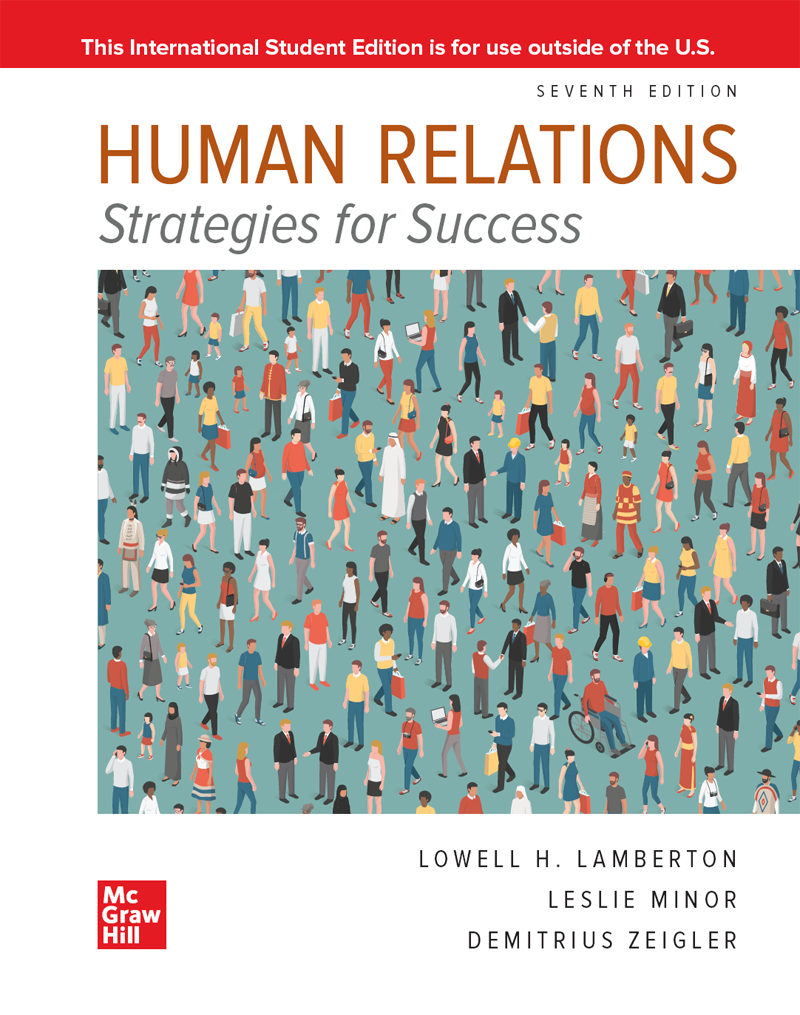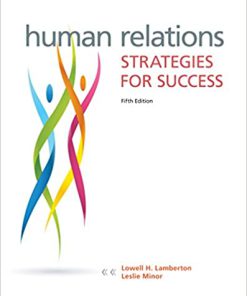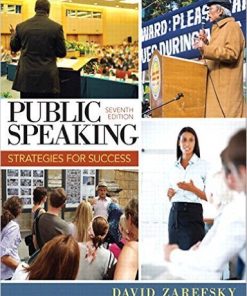Human Relations Strategies for Success 7th Edition by Lowell Lamberton 1264071086 9781264071081
$50.00 Original price was: $50.00.$25.00Current price is: $25.00.
Human Relations: Strategies for Success 7th Edition by Lowell Lamberton – Ebook PDF Instant Download/DeliveryISBN: 1264071086 9781264071081
Full download Human Relations: Strategies for Success 7th Edition after payment.

Product details:
ISBN-10 : 1264071086
ISBN-13 : 9781264071081
Author : Lowell Lamberton
Human Relations: Strategies for Success, 7e, by Lamberton, Minor or Zeigler will help you prepare for this changing world. This text covers time-tested, research-based social science and management principles, as well as newer theories and philosophies of human relations drawn from management theory, group theory, personality theory, and relationship theory. More than ever, effective relations skills are crucial to business success as organizations grow and compete in a global business environment. Employees must have the knowledge and skill to adapt to a workplace where change is frequent and inevitable.
Human Relations: Strategies for Success 7th Table of contents:
Part 1: Human Relations and You
Chapter One: Human Relations: A Background
What Is Human Relations?
The Importance of Human Relations Skills
Human Relations and You
Current Challenges in Human Relations
Increased Competition in the Workplace
Family Work Dynamics Changing
“Sandwich Generation” Getting Cheesed
What Human Relations Is Not
Areas of Major Emphasis
Self-Esteem
Mutual Respect
Self-Awareness and Self-Disclosure
Communication Skills
Group Dynamics
Motivation
Growth Mindset
A Brief History of Human Relations
The Early Years
Human Relations and Bureaucracy
Scientific Management
Frank and Lillian Gilbreth
Mary Parker Follett
The Hawthorne Experiment
Human Relations and Management
Human Relations, History, and the Individual
Strategy for Success 1.1 Develop Mutual Respect
Strategy for Success 1.2 Build Your ommunication Skills
Summary
Working It Out 1.1
Working It Out 1.2
Working It Out 1.3
Case Study 1.1
Case Study 1.2
Chapter Two: Self-Concept and Self-Esteem in Human Relations
What Is Self-Concept?
The Four Parts of the Self-Concept
Ideal Self
Looking-Glass Self
Self-Image
Real Self
Focusing on the Real and Ideal Selves
Balancing Your Needs and the Needs of Others
What Is Self-Esteem?
Self-Esteem and Work Performance
Types of Self-Esteem
Origins of Self-Esteem
Achieving Higher Self-Esteem
Strategy for Success 2.1 Steps toward Combating Low Self-Esteem by Defeating the Inner Critic
Building Self-Concept: Growth Mindset
Strategy for Success 2.2 Build Your Growth Mindset
Summary
Working It Out 2.1
Working It Out 2.2
Working It Out 2.3
Case Study 2.1
Case Study 2.2
Chapter Three: Self-Awareness and Self-Disclosure
What Is Self-Awareness?
Awareness-Related Barriers to Effective Human Relations
The Johari Window
The Open Pane
The Hidden Pane
The Blind Pane
The Unknown Pane
What Is Self-Disclosure?
Outcomes of Failing to Self-Disclose
Levels of Communication as They Relate to Disclosure
Level 5: Cliché Conversation
Level 4: Reporting the Facts about Others
Level 3: Expressing Ideas and Judgments
Level 2: Expressing Feelings and Emotions on the “Gut Level”
Level 1: Peak Communication
A Key to Improved Human Relations—Level 2
Making Assumptions about Other People
The Risk Factor of Disclosure
Strategy for Success 3.1 Know When to Stop
Strategy for Success 3.2 Pay Attention to Differences
Strategy for Success 3.3 Facing Fear of Self-Disclosure
Summary
Working It Out 3.1
Working It Out 3.2
Working It Out 3.3
Working It Out 3.4
Case Study 3.1
Case Study 3.2
Chapter Four: Attitudes and Values in Human Relations
What Is an Attitude?
What Makes a Good Attitude?
Changing Existing Attitudes
Attitudes and Job Satisfaction
What Are Values?
Values versus Attitudes
Where Your Values Come From
Values Conflicts
Interpersonal Values Conflicts
Personal versus Group Values
Internal Values Conflicts
Values in an International Economy
Strategy for Success 4.1 Changing Pessimism to Optimism
Strategy for Success 4.2 Building Positive Attitudes at Work
Strategy for Success 4.3 Redefining Your Personal Values: The Rath Test Strategies for Success
Summary
Working It Out 4.1
Working It Out 4.2
Working It Out 4.3
Working It Out 4.4
Case Study 4.1
Case Study 4.2
Chapter Five: Motivation: Increasing Productivity
What Is Motivation?
Organizational Climate and Morale
Intrinsic and Extrinsic Rewards
Need-Based Theories of Motivation
Abraham Maslow’s Hierarchy of Needs
Alderfer’s ERG Theory
McClelland’s Manifest Needs Theory
Herzberg’s Two-Factor Theory
Job Enrichment: Hackman and Oldham
A New Motivational Strategy: Gamification
Behavior-Based Theories of Motivation
Expectancy Theory
Reinforcement Theory and Behavior Modification
Goal Setting
Reinforcement, Values, and Self-Esteem
Motivation and Self-Esteem
Self-Esteem and Job Performance
Strategy for Success 5.1 Applying McClelland’s Theory
Strategy for Success 5.2 Changing Your Behavior
Summary
Working It Out 5.1
Working It Out 5.2
Working It Out 5.3
Working It Out 5.4
Case Study 5.1
Case Study 5.2
Part 2: Human Relations in Groups
Chapter Six: Communication and Human Relations
Communication and Miscommunication
Online Communication
Listening—and How It Can Fail
Selective Listening
Tuning Out
The Timing of Messages
Emotional Timing
Situational Timing
Relevance Timing
Filtering
Communicating without Words
Functions of Nonverbal Messages
Nonverbal Messages about Self-Esteen
Gestures and Their Meanings
Distance Between Speakers
Communicating in an Organization
Grapevines
Speaking Effectively
International and Intercultural Communication
Strategy for Success 6.1 Become a Better Listener
Strategy for Success 6.2 Practice High-Context Communication
Summary
Working It Out 6.1
Working It Out 6.2
Working It Out 6.3
Working It Out 6.4
Case Study 6.1
Case Study 6.2
Chapter Seven: Teamwork and Leadership
Groups and Teams
What Makes a Group?
Groups at Work: Teams
Team Development
The Five Stages of Team Development
Team Building
Implementation
Trust
Goals
Communication in Teams
Meeting Etiquette
Tips for Online “Virtual” Meetings
Barriers to Team Effectiveness
Making Teams More Effective
Hidden Agendas
Leadership: What It Is and What It Requires
Leadership versus Management
Leadership Styles
Leaders and the Use of Power and Authority
Sources of Power
Organizational Climate: The Weather of the Workplace
Major Qualities of Organizational Climate
Maintaining a Climate
Organizational or Corporate Culture: Shared Values
Today’s Organizational or Corporate Culture: A Focus on Fairness
Strategy for Success 7.1 Watching for Hidden Agendas
Strategy for Success 7.2 Building a Successful Team
Summary
Working It Out 7.1
Working It Out 7.2
Working It Out 7.3
Working It Out 7.4
Case Study 7.1
Case Study 7.2
Chapter Eight: Achieving Emotional Control
The Eight Forms of Intelligence
Language
Math and Logic
Music
Spatial Reasoning
Movement
Interpersonal Intelligence
Intrapersonal Intelligence
Naturalist Intelligence
Triarchic Intelligence
Emotional Intelligence
Learning to Apply Emotional Intelligence
Handling Strong Emotions
Five Steps for Dealing with Anger and Other Strong Emotions
Assertive, Aggressive, Passive
Defensive Behaviors
Positive Intelligence: Know Your Inner Saboteur
Strategy for Success 8.1 Defeating Your Inner Saboteur
Scripts
Games People Play
“Why Don’t You . . . Yes, But”
Wooden Leg
Harried (or Harried Executive)
Now I’ve Got You
Strategy for Success 8.2 Stopping Games before They Start
Summary
Working It Out 8.1
Working It Out 8.2
Working It Out 8.3
Case Study 8.1
Case Study 8.2
Part 3: Building Your Human Relations Skills
Chapter Nine: Individual and Organizational Change
Change as a Fact of Life
Technical Innovation Creates Change
Recognizing Stress, Managing Change
The Seven Stages of Personal Change
Managing Life Changes
Evaluate Your Level of Control
Practice Self-Care After a Loss
Check Your Thought Patterns
Be in the Present
Find Your Priorities
Models of Organizational Change Management
The Lewin Change Model
Current Criticism of Lewin’s Change Model
Force Field Analysis
Logical Incrementalism
Additional Organizational Change Models
Accepting Change
Approaches to Continuous Improvement
Kaizen
Six Sigma
Lean
Organizational Development
Strategy for Success 9.1 Managing Personal Change in the Workplace
Strategy for Success 9.2 Gaining Acceptance for Change in Your Organization
Summary
Working It Out 9.1
Working It Out 9.2
Working It Out 9.3
Case Study 9.1
Case Study 9.2
Chapter Ten: Creativity and Human Relations
The Creativity Connection
What Is Creativity?
“Flow” and Creativity in Our Everyday Lives
Perception and Creativity
Inside the Creative Process
Step One: Perception and Preparation
Step Two: Incubation
Step Three: Inspiration
Step Four: Verification
Creativity in the Workplace
Managing Creativity
Fostering Creativity
Creative Methods for Groups
Brainstorming
Reverse Brainstorming
The Nominal Group Method
Creative Problem Solving
Strategy for Success 10.1 Increase Your Creativity
Strategy for Success 10.2 Roger von Oech’s “Ten Mental Locks”
Strategy for Success 10.3 Use SCAMPER to Solve Problems
Summary
Working It Out 10.1
Working It Out 10.2
Working It Out 10.3
Case Study 10.1
Case Study 10.2
Chapter Eleven: Conflict Management
Types of Conflict
Sources of Conflict
Content Conflict
Values Conflict
Negotiation-of-Selves Conflict
Institutionalized Conflict
Conflict Analysis
Potential Solutions
Win–Lose
Lose–Lose
Win–Win
Styles of Conflict Management
Special Conflict Cases
Low Conformers
Envious People
Whiners and Complainers
Passive, Unresponsive People
Snipers and Intimidators
The Grinch and the Gossip
Strategy for Success 11.1 Negotiate Win-Win Solutions
Strategy for Success 11.2 Make Collaboration Work
Strategy for Success 11.3 Stop Conflicts before They Start
Summary
Working It Out 11.1
Working It Out 11.2
Working It Out 11.3
Case Study 11.1
Case Study 11.2
Chapter Twelve: Stress and Stress Management
Causes of Stress
Life Changes and Daily Hassles
Chronic Stressors
Life Changes as Stressors
Sources of Stress
External Stressors
Internal Stressors
Type A and Type B Personality Behavior
The Physical Effects of Stress
How Our Bodies Adapt to Stress
Stress and the Immune System
The Cost of Stress in the Workplace
Managing Stress
Strategy for Success 12.1 Discard Irrational Beliefs
Strategy for Success 12.2 Change Your Behaviors to Reduce Stress
Strategy for Success 12.3 Take Care of Yourself
Summary
Working It Out 12.1
Working It Out 12.2
Working It Out 12.3
Case Study 12.1
Case Study 12.2
Chapter Thirteen: Your External and Internal Customers
What Do Customers Really Want?
What Is Good Customer Service?
The Internal Customer
The Two Simplest Principles of Customer Service
Issues in Customer Service
Your Customers and Your Attitude
Delivering Bad News
Encouraging Complaints
Handling the Difficult Customer
Going the Extra Mile
Customer Service Ethics
Poor George Story
Strategy for Success 13.1 Establish a Bond with the Customer
Strategy for Success 13.2 Support the Customer’s Self-Esteem
Strategy for Success 13.3 Handle the Difficult Customer Professionally
Strategy for Success 13.4 Keep Customers Satisfied
Summary
Working It Out 13.1
Working It Out 13.2
Working It Out 13.3
Case Study 13.1
Case Study 13.2
Part 4: Thriving in a Changing World
Chapter Fourteen: Human Relations in a World of Diversity
A Diverse Society
A Changing Labor Force
Positive Attitudes about Diversity in the Workplace
The Benefits of Diversity and Inclusion in the Workplace
Why Is Workplace Diversity Important for Businesses?
Why Is Diversity Good for Employees?
Removing Barriers to a Diverse Workplace
Attitudes that Create Limitations
Origin of Prejudice
Sexual Harassment
Discrimination
Recognizing Discrimination
Racism
Economic Prejudice
Sexism
Overweight People
The LGBTQ Workforce
The Elderly
People with Disabilities
Religious Groups
Pregnant Women
Cultural Intelligence
Strategy for Success 14.1 Build Your Cultural Intelligence
Looking Ahead
Strategy for Success 14.2 Assess Your Knowledge
Strategy for Success 14.3 Reducing Sexual Harassment
Summary
Working It Out 14.1
Working It Out 14.2
Working It Out 14.3
Case Study 14.1
Case Study 14.2
Chapter Fifteen: Business Ethics and Social Responsibility
What Is Ethics?
Ethics and the Internet
Codes of Ethics
Rationalizing Unethical Behavior
Ethics in Context
The Influence of Group Goals
Global Ethics Issues
A Historical Perspective
The Inner Circle
Future Favors
Gift Exchange
Social Responsibility
A Few Cautions about Social Responsibility
Blowing the Whistle
Strategy for Success 15.1 Making Ethical Decisions: A Quick Ethics Test from Texas Instruments
Strategy for Success 15.2 Navigating the Ethics of Global Business
Summary
Working It Out 15.1
Working It Out 15.2
Working It Out 15.3
Working It Out 15.4
Case Study 15.1
Case Study 15.2
Chapter Sixteen: A Productive Workplace and Success
A Productive Workplace
Increasing Morale to Boost Productivity
Productivity and Task Maturity
Avoiding Self-Sabotage
Steps to Stop Procrastinating
Time Management
Behaviors that Reduce Workplace Productivity
Substance Abuse: Alcohol and Other Drugs
Recognizing Alcohol Abuse in the Workplace
Employee Drug Abuse and Dependency
The Effects of Substance Abuse in the Workplace
Marital, Family, and Other Personal Problems
Financial Problems
Responses to Substance Abuse and Other Nonproductive Behaviors
Employee Assistance Programs
Workplace Substance Abuse Policies
What Else Can Be Done for Employees?
Human Relations in Your Future
Your Definition of Success
Self-Perception, Confidence, and Success
Self-Discipline and Success
Self-Motivation, Self-Direction, and Success
Fear: The Enemy of Success
Positive Psychology
Finding Your Niche
Prepare for a Career Choice
Strategy for Success 16.1 Goals for Success
Strategy for Success 16.2 Make an Inventory of Your Skills
Strategy for Success 16.3 Define Your Goals
People also search for Human Relations: Strategies for Success 7th:
human relations strategies for success 6th edition pdf free
human relations strategies for success 7th edition pdf free
human relations strategies for success pdf
human relations strategies for success 7th edition ebook
human relations strategies for success 6th edition
Tags:
Human Relations,Strategies,Success,Lowell Lamberton
You may also like…
Uncategorized
Business & Economics
Effective Communication & Soft Skills: Strategies For Success 1st Edition
Education Studies & Teaching - School Education & Teaching
Uncategorized
Uncategorized
Uncategorized
(eBook PDF) Your College Experience: Strategies for Success 13th Edition by John N. Gardner
Humanities and Social Sciences
eTextbook 978-0205857265 Public Speaking: Strategies for Success












